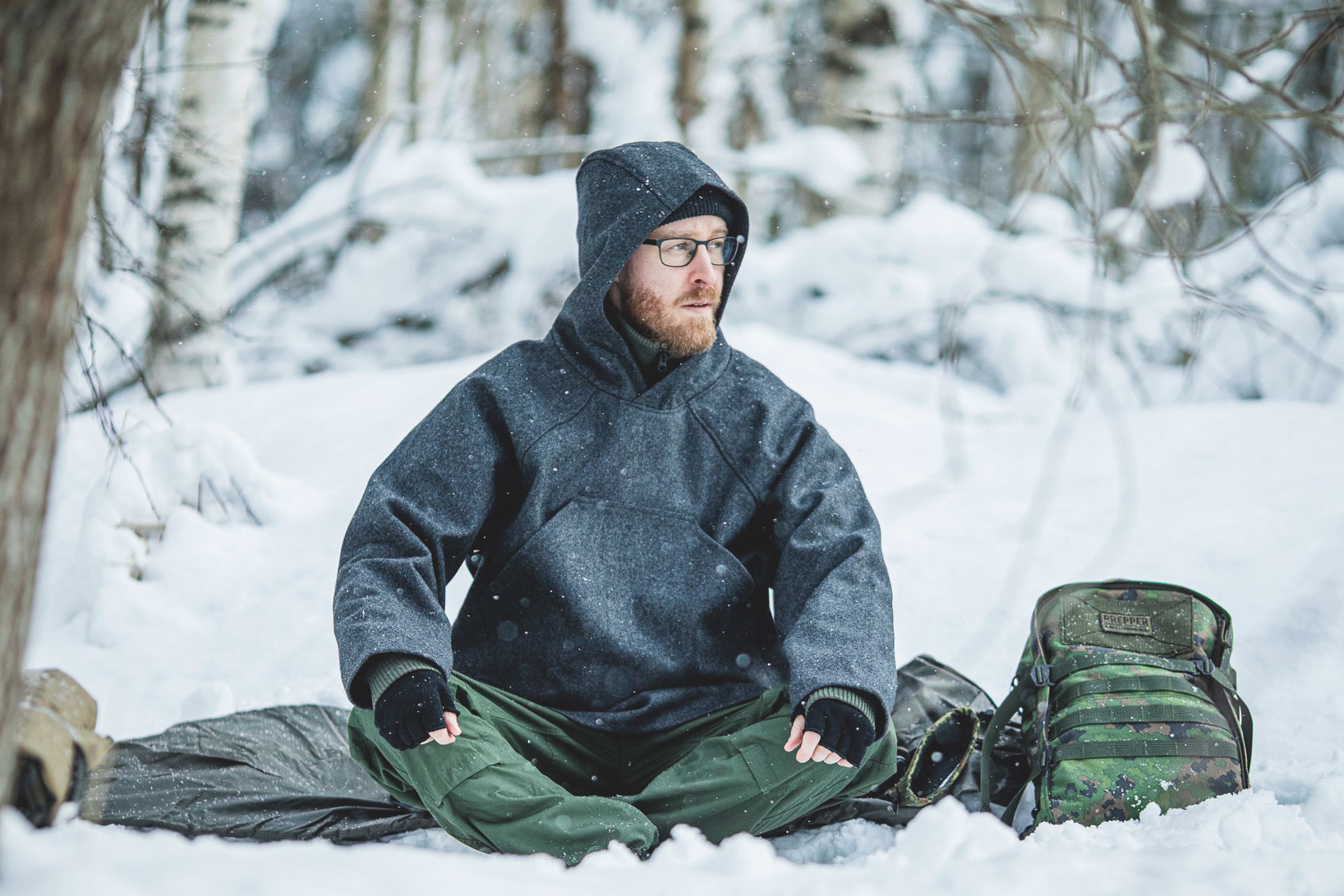
World of Bushcraft
World of Bushcraft
What is bushcraft? Well, it is all sorts of cool stuff in the woods that could fill a range of books. And it probably has - both beginner bushcraft and more advanced one. Here’s a quick overview of the world of bushcrafting. We will delve deeper into the subject in future articles.
Bushcraft, what is it?
Bushcrafting is very popular all over the world these days, but it isn’t a modern invention. The term covers surviving and thriving in the wilderness plus all sorts of handicrafts. The word "bush" has been used in English at least since the 19th century. Originally, it came from Dutch to first South African and then Australian English, referring to woodland and other natural areas not cleared for farming. Nowadays the term bushcraft is used all over the world in the English format although some languages have their own terms as well.
Traditional bushcraft skills have been a vital part of life ever since we learnt to walk and right until the early 20th century. Before agriculture, hunting, fishing, and gathering were the only ways to acquire your food. And even with farming, they were necessary for complementing your diet and getting some extra income. In Finland, the soldiers of both the Winter War and Continuation War knew how to use the terrain and weather conditions a lot better than Russian invaders, and our long-range recon troops were capable of living in the wilderness during their long missions in all sorts of weather.
In the course of urbanization, old wilderness skills and even the newer ones started to fade away from people’s memory, since they were no longer necessary in everyday life. Luckily there were always some folks that kept them alive through their hobbies. And it would be good for all of us to know the most essential bushcrafting skills in case you e.g. happen to get lost in the woods.
When you talk about bushcraft, survival isn’t the whole story. Thus, the term isn’t a synonym to prepping, although bushcrafters, survivalists, and preppers do study some of the same skills. However, the preppers prepare for some impending doom and seek to survive through those conditions. And many concentrate on urban survival. And bushcrafters voluntarily go to enjoy the miserable conditions in the wilderness and don’t necessarily want to come back.
How to bushcraft?
Bushcraft is a very wide-ranging concept and it can mean different things to different people. Generally speaking it covers all the skills needed for surviving and thriving in the wilderness. Food, water, warmth, and shelter together with land navigation, so that you find your way out of there when needed. Some also add the making and modifying bushcraft clothing and bushcraft gear.
There are all sorts of bushcraft people out there, and there isn’t just one true way. Some combine a traditional thing or two to otherwise modern hiking. They e.g. make fire with flint and steel or always sleep in an open shelter. Some learn traditional bushcraft skills just in case the modern methods fail. In case the GPS device dies, they will use the map and compass, otherwise they don’t. Then there are folks that aren’t really interested in wilderness skills but like to learn new handicrafts, such as how to build a bushcraft shelter, how to make a bushcraft chair, how to make bushcraft clothing, how to make bushcraft gear, or how to make bushcraft knots.
There are even those that are into historical bushcrafting or even primitive bushcrafting. Some historical reenactors study the bushcraft traditions of a certain era and region and try to recreate them as closely as possible. Some, for example, hunt with muzzleloaders or primitive bows, and the whole kit is from the same era. There are lots of historical bushcrafters to pick, ranging from the Stone Age hunter-gatherers, Iron Age fur traders, 18th century longhunters, and even the WWII guerrillas. Researching the topic and finding out everything you can about the gear is a big part of the fun.
Some people also combine bushcraft with self-sufficiency and environmental thinking. It is a lot better for the environment to mend and modify good-quality bushcrafting gear and clothing rather than keep buying poor quality crap. There are most likely also many other ways to enjoy bushcrafting. All the different bushcraft types fit nicely together - at least in the wilderness, not sure about various online discussion groups though.
Water
Without water you will not go very far. On shorter trips, it is possible to bring water with you, for example in a hydration reservoir or a canteen. On longer ones you need to do what your ancestors did and get water from the wilderness. In Finland, it is very easy to find water, since we have thousands of lakes here plus rivers, ditches, and such. Some countries aren’t that lucky and finding water is another necessary skill. And on top of that, there is the tricky bit of knowing what water is safe to drink.
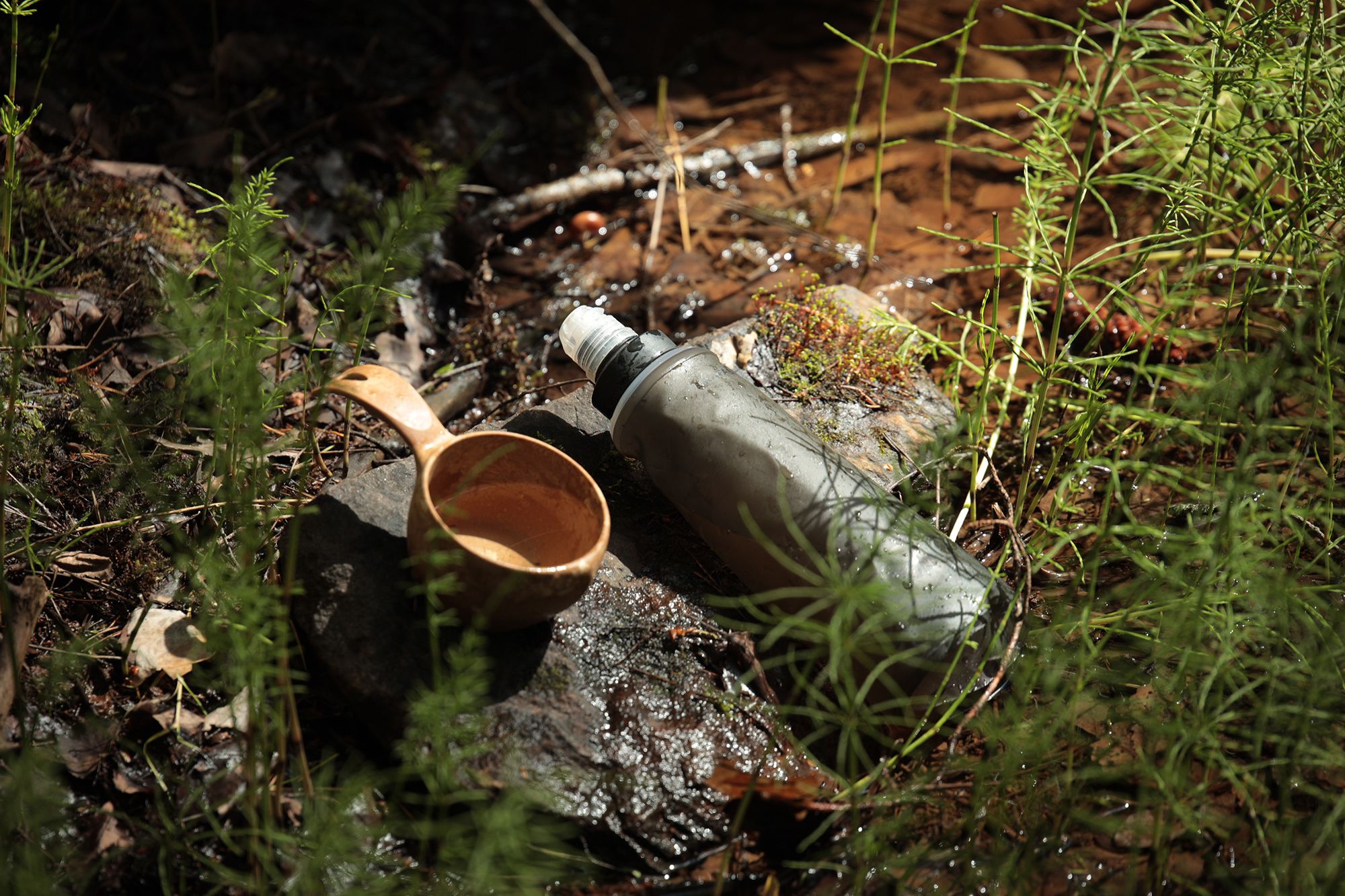 If you’re worried about the water quality, a water filter is a good thing to have. Some filter it when you suck on the straw, some by pumping the water through the filter.
If you’re worried about the water quality, a water filter is a good thing to have. Some filter it when you suck on the straw, some by pumping the water through the filter.
Avoid drinking stagnant water anywhere. The further north you go, the cleaner the water usually is. Nevertheless the only way to make sure that the water hasn’t got any nasty surprises is to purify it. Boiling it is the most traditional way but if you want something faster, water disinfection tablets and water filters are the way to go. Tablets make the water taste a bit funky but they also kill viruses, which the filters don’t do. Personally, I bring a water filter even on more traditional trips because I don’t feel like having any Exorcist reenactment at night.
Food
You can survive a bit longer without eating but being hangry isn’t that fun, and you have more energy for wrestling forest trolls after you’ve had some grub. Hiking food made on a hiking stove is the simplest option and a very good alternative for a modern bushcrafter. However, the traditional bushcrafter goes a bit further and makes everything on the open fire, preferably from ingredients caught or picked by themselves.
Combining hunting, fishing, and foraging with bushcrafting is possible in many countries today, but it requires you to know the local regulations. And of course you need to be out and about during a season when you actually can find something to eat legally. In Finland, the fall season is the most versatile because you can do all of these.
Of course if you acquire wild food outside your bushcrafting activities, you can grab some nice ingredients from home before going adventuring. If it is not too warm, you can e.g. bring along some frozen and vacuum-packed game and cook it by the campfire. And dried goodies will survive in all sorts of temperatures a lot longer than you can stay in the forest.
I have a habit of going canoeing for a week in the wilderness in September/October, which is a perfect time to hunt, fish, and forage. When you bring very little food with you, you get a good motivation to acquire it from nature. At the same time it is nice to test both traditional and primitive cooking methods.
 Foraging
Foraging
Mushroom and berry picking are so called "everyman’s rights" here in Finland. You can pick them freely as long as you don’t do it in anybody’s yard or in certain conservation areas. Wild plants have more complicated regulations and some of them, like spruce tips, require the landowner’s permission. Other countries have other rules, so make sure you know them before picking anything. And of course know what you pick or risk meeting the reaper.
Fishing
Fishing regulations vary from country to country, region to region, and also based on what time of the year it is and what equipment you use. So, before making fishing part of your bushcrafting activities, find out how the rules work in the area where you want to go and with the fishing gear you wanna take along. Luckily you can find out most of these things online nowadays.
Fishing gear choices depend on what kind of bushcrafting adventures you want to have. If you go by canoe, you can easily do some bowfishing/spear fishing or bring along a net or a foldable fish trap, provided that it is permitted in your neck of woods. A minimalist will only bring a hook and a fishing line. A primitive bushcrafter makes them from scratch.
Hunting
In most countries hunting is quite controlled and might require things like a hunter’s exam/hunting license, gun permits, game tags, etc. You also need to hunt during the hunting season, which will vary from country to country, region to region, and from one game animal to another. Some countries allow hunting with muzzleloaders, bowhunting and even hunting with spears, atlatl, and various traps. Others don't, so check it in advance.
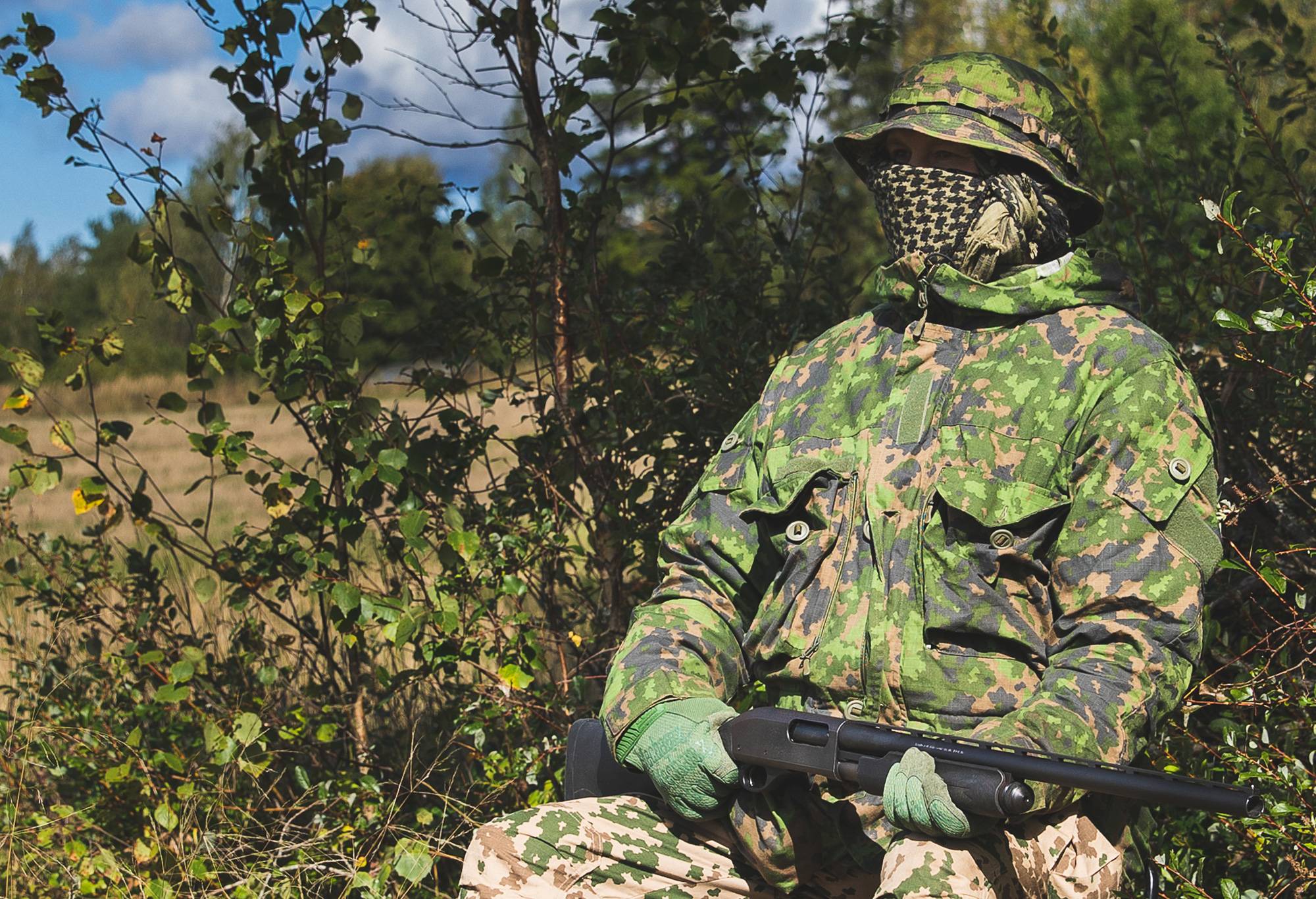 Hunting is a good way to add food on the table on a bushcraft trek.
Hunting is a good way to add food on the table on a bushcraft trek.
Cooking
When you’ve acquired the ingredients yourself, it is nice to spend a bit more time on cooking as well. Open fire, cast iron pots and pans, and primitive cooking methods that require no dishes, such as ember-roasting, planked fish, baking in clay, and wooden skewers are already screaming your name... Of course it is also sensible to have a more modern alternative at your disposal, such as Trangia or a hobo stove in case open fire cooking isn’t an option for one reason or another.
Fire starting
Making a fire is one of the most essential beginner bushcraft skills, but the modern legislation puts all sorts of restrictions on it. Which is good because it isn’t fun to burn half the planet with reckless campfires. In most places you need the landowner’s permission to build a fire unless it is an emergency (being hangry isn’t one). Most countries also have restrictions and bans in conservation areas and during the dry season. Check out the rules and restrictions beforehand.
Firemaking requires three things: heat, oxygen, and fuel. Lack one and it won’t work. For a modern bushcrafter, the most common source of heat is probably matches, but when it rains cats and catastrophes, it is worth to have proper storm matches.
Actual bushcrafting begins when you make fire without modern marvels. There are several options, which you should practice in peace beforehand because it won’t be very jolly in an emergency. The most common option is the flint, steel, and tinder, e.g. char cloth made from natural fibers, such as linen. If you want to go even further back in time, you can use e.g. a bow drill. And if you don’t want to dive into the deep end at once, a modern firesteel is a great alternative.
 A few firemaking options. From the left: storm matches, waterproof matches, modern firesteel, and traditional flint and steel.
A few firemaking options. From the left: storm matches, waterproof matches, modern firesteel, and traditional flint and steel.
An old Finnish campfire "rakovalkea", known in English as a slit fire, has saved many a traveler in the past. However, nowadays they are quite rare because of regulations regarding wood use in forests. So, usually only available for landowners and their friends, and even then only if you have pine trees that have died while standing and dried there. Building a proper slit fire also takes a lot of time and energy. If you have a possibility to sleep by one, it is definitely worth the effort.
Shelter
What is bushcraft camping? To some it is ultralight, to some comfortable, and to others primitive. Traditional bushcrafters enjoy spending a night in an open shelter, a snow cave, a bedroll, or some other more time and effort taking and less comfort providing shelters. It is quick and easy to build a lean-to using a tarp or shelter half. If the landowner allows it, you can also build it from young tree trunks, branches and other natural materials. When there’s enough snow, you can also sleep in a snow cave - but learn to build it properly or you can be buried underneath it and suffocate.
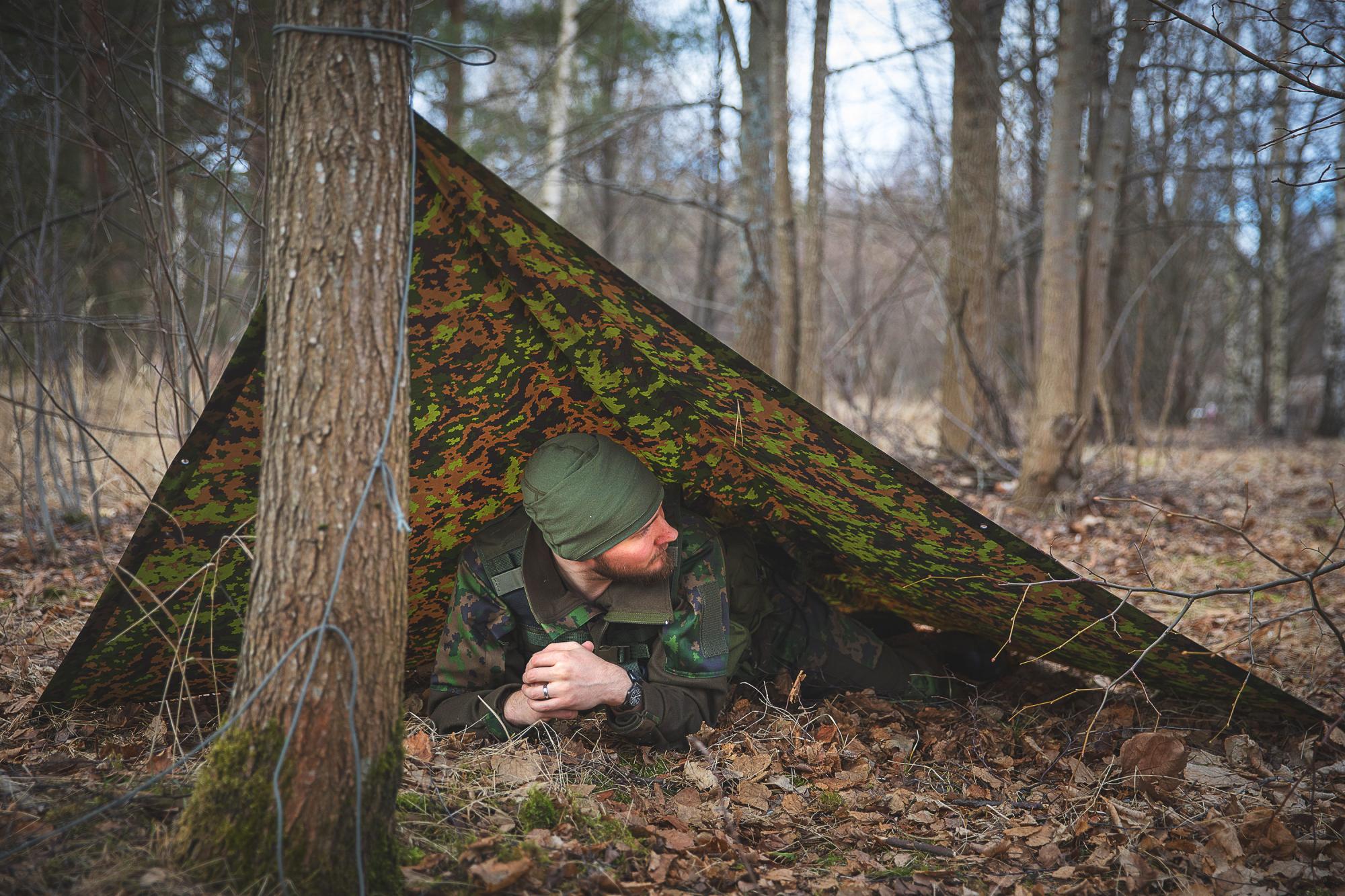 You can seek that lovely discomfort even with more modern gear.
You can seek that lovely discomfort even with more modern gear.
A spruce branch bed and wool blanket (plus a reindeer skin in Lapland) have been the traditional companions of a Finnish outdoorsman sleeping by a slit fire for centuries. But since modern regulations often make cutting branches and having big fires very difficult, most Finnish bushcrafters use a sleeping bag and possibly also a sleeping pad when it is really cold. Deer/reindeer hides are still an optional sleeping pad, but you should choose a scraped but untanned hide to make sure it doesn’t shed so much. During warmer seasons or or in a more moderate climate, a wool blanket is still quite a nice option.
Campcraft
For many bushcraft enthusiasts, covering long distances isn’t a priority. The best part of the hobby lies in setting and fine-tuning the camp, and fiddling with this and that by the campfire. Bear in mind that the more intricate camp setup you want, the more crap you need to haul with you, and the more difficult it will be to travel long distances. A canoe fits lots more than a backpack, so if you are into campcrafting but also want to travel further than where you parked your car, it might be a sound choice when the waters aren’t frozen. And an expedition sled when they are.
 There are plenty of crafts to choose from. You can build a separate kitchen shelter, make tripods, skewers, and hooks for cooking, try out various knots, carve spoons and ladles, whittle more tinder, or even build an earth oven as long as the terrain, fire regulations, and the landowner allow it.
There are plenty of crafts to choose from. You can build a separate kitchen shelter, make tripods, skewers, and hooks for cooking, try out various knots, carve spoons and ladles, whittle more tinder, or even build an earth oven as long as the terrain, fire regulations, and the landowner allow it.
Bring along the tools you need for the things you want to do. A knife and an axe will take you quite far. Take a Skrama instead of the axe if you want to travel lighter and a saw if you want to be more energy-efficient. On top of that, spoon-carving knives plus other tools if needed. A multitool is useful in many tasks. Technically, a rope isn’t a tool but still a must for many a bushcrafter. Paracord is quite a handy option for many tasks as long as you don’t use it too close to a fire.
Land navigation
We all know how to find our way into the forest but it takes a bit more skill to get out of there. Modern-day bushcrafters have all sorts of digital devices at their disposal. A GPS device or an application is indeed good to have at least just in case, but traditional bushcrafters prefer a map and compass. They may be old but at least they won’t run out of batteries. Paper maps can nowadays be bought online plus at different places locally depending where you want to go. If there isn’t a map available of the place where you want to go, you might want to choose a different location. If you want to be even more old-school, you can learn to find your way with the help of the sun, moon, and stars. However, at least here in Finland, it is cloudy so often that it might take a while to see any of those.
Avoiding dangers
In Finland, nature is quite safe but even here you can end up in trouble if you don’t know what you’re doing. And there are lots of countries out there where nature can be very hostile. Find out what kind of terrain, flora and fauna, and possible weather changes to expect and rather be over- than underprepared. Make sure you bring the necessary gear to minimize those hazards and try avoiding them as well as you can during the trip. Below a few examples.
Edible stuff
- Don’t pick berries, mushrooms, or plants that you don’t absolutely know. There are loads of poisonous things out there that can kill you. And many of those who ate themselves to death were "experienced foragers".
- Some fish species can have parasites, so bush sushi might not be the best meal plan. Or at least you need to know, which ones you can eat raw.
- The warmer the weather is, the easier certain food items go bad. Take that into consideration when making your meal plan. Dried and heavily salted stuff stays edible the best and seafood and milk the worst.
Animals
- If the region has ticks, scorpions, or other unpleasant creepy-crawlies, use clothing that best keeps them away from bare skin. And check your boots, shoes, and nooks and crannies regularly.
- If there are some bigger beasts that might wanna eat you, take appropriate precautions. In Finland, it is usually enough to be noisy and smelly, and our bears will leave you alone. They don’t like to eat people in any case but might be protective of their cubs. Somewhere else there might be a need for a gun, bear spray, or to avoid the area altogether.
- Look where you step to avoid snakes and wasp nests. If you suddenly hear a lot of buzzing, make a hasty retreat.
- Don’t clean game or fish in your camp in warm weather if you have wasps or something else that might like it too much. Somewhere else you might not wanna do it in cold weather either, it might attract something a lot bigger. If you have curious bears or other thieves in the area, you also want to hoist your food in a barrel in a tree.
Terrain
- Whenever you walk on frozen water avoid thin ice and keep ice claws easily accessible. Keep spare clothing and your fire-making kit in a waterproof sack.
- When crossing marshland, carry along a staff that you can use to test the ground in front of you. And stay clear of the really wet bogholes.
- If the terrain is very rocky or otherwise hazardous for your ankles, wear hiking boots that offer good ankle support. They are great in normal terrain as well.
- When traveling by open-top canoe, it might be good to avoid crossing large lakes. Sometimes it can get stormy very suddenly. Always wear a lifejacket.
Weather
- Test your winter gear on shorter trips before embarking on a long North Pole expedition. It sucks to notice there that you don’t have enough layers to keep you alive.
- Make sure that you have enough spare clothes in case you cannot dry them by the campfire. Wool is nice because it is a lot more pleasant than modern materials when wet. Rain gear might also be good to have if you cannot build a fire and the trip is long.
Oopsy-daisy
- Keep a first aid kit with you, and learn to use everything in it in case someone has an accident.
- If you have a habit of cutting yourself with sharp things, maybe bring along a cut-resistant glove.
- It is a bit sucky to do anything productive with a barbed fishing hook stuck in your eyebrow. Good wire cutters are a must if you plan to do more fishing.
First aid
The best first aid is to not hurt yourself but it is worth preparing for the possibility that something goes wrong, especially if you stay in the bush for a longer period of time. Therefore, first aid is an extremely important bushcraft skill. And we mean modern first aid, because you shouldn’t mess with anyone’s health. No matter how primitive caveman you want to be, carry along an up-to-date first aid kit. Old folk remedies are fun from a historical perspective, and they can be of some use if you are out of everything else. But you shouldn’t risk anyone’s life using them if you have more efficient options at hand.
 The modern first aid kit is an essential piece of gear no matter how much of a traditionalist you are.
The modern first aid kit is an essential piece of gear no matter how much of a traditionalist you are.
Bushcraft clothing
Some bushcrafters dress in modern outdoor clothing, some combine them with traditional items or materials, and others go purely with ol’-time choices. There’s a lot of variety, and not all even consider clothing to be part of bushcraft. However, since the right clothing choices are an essential part of survival, we wanna say a few words about this subject as well.
People have survived in rough conditions using clothes and footwear made from natural materials throughout our history. First in clothing and footwear made from purely animal skins and hides, and later complementing them with fabrics woven from animal and plant fibers. Natural materials work perfectly well nowadays, too, as long as you use them wisely. Dressing in layers that work is vital for survival, because cold can kill you, certain materials are very difficult to dry, and synthetic fabrics & open fire is a marriage made in hell. Warming by a campfire works in any clothing but if you need to cook very close to it, natural fibers are the thing.
Where to buy traditional bushcraft clothes
It is still possible to buy more traditional wool outdoor gear even brand new. However, often the price is quite high because Loden/tweed clothes are often worn in Central Europe and Britain by people that don’t have monetary problems.
Varusteleka’s own modern traditional bushcraft outfit, Särmä TST Woolshell Jacket together with Woolshell Pants, is a big hit among our bushcraft gang, and the price is a lot nicer than Central European or British wool clothes. If you want to go even more traditional, we also have the Särmä Blanket Shirt and Särmä Luhka that you should catch whenever they are available, because they go very fast. And Merino wool is lovely to have next to your skin plus as a mid-layer.
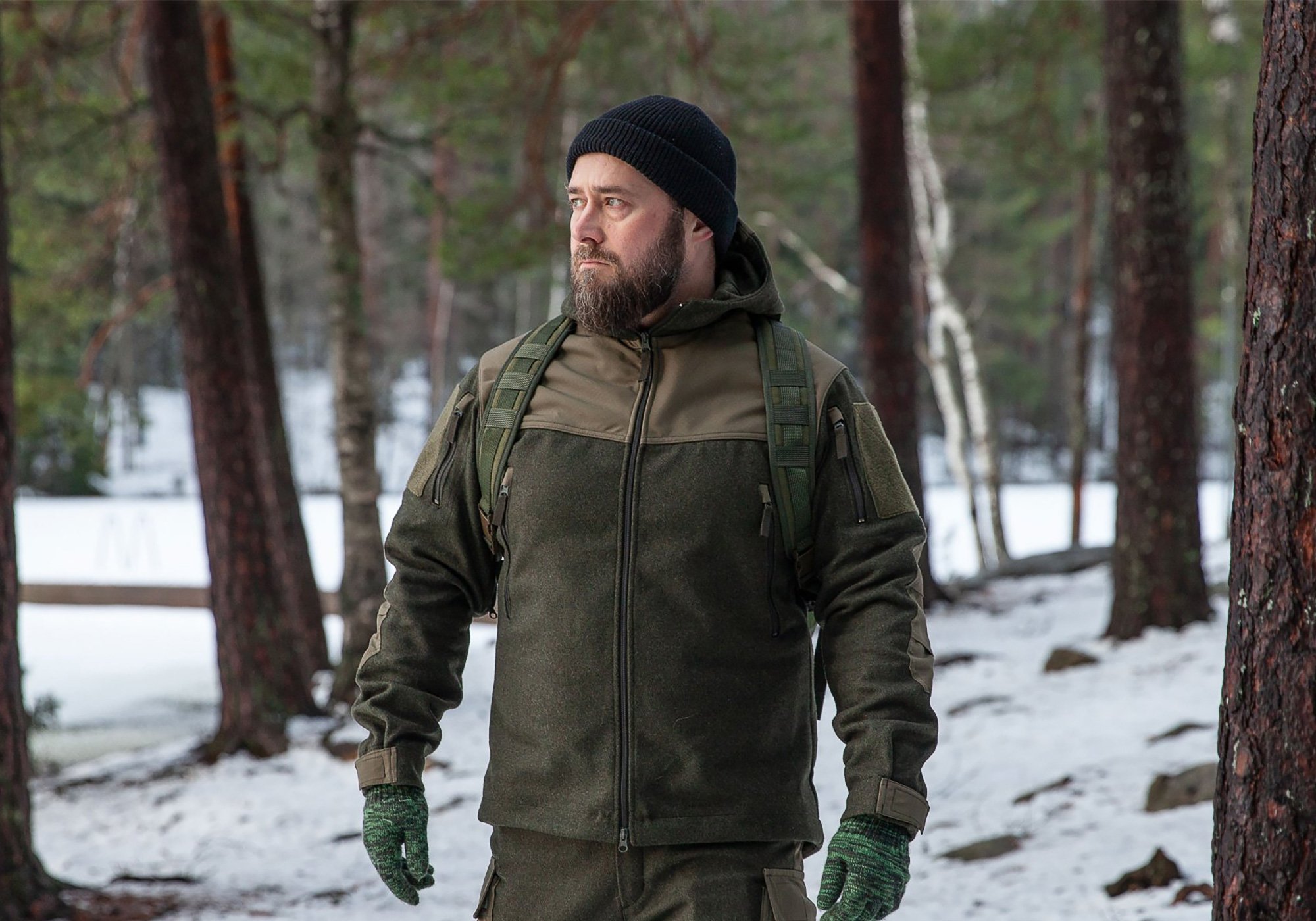 Woolshell is the choice of a happy Finnish bushcrafter.
Woolshell is the choice of a happy Finnish bushcrafter.
If your budget is very limited, keep an eye on our military surplus section. We sometimes get very affordable wool frieze pants, army sweaters, and other cool stuff even for more modern bushcrafters. Furthermore, flea markets and Ebay, and other online trading places sometimes yield very nice treasures.
DIY bushcraft clothes
When you make things yourself, you get exactly what you deserve. You can either make your bushcrafting clothes from scratch or modify existing clothes to be more suitable or more personalized.
In North America, the traditional hunter and trapper coat is the capote, which is also known as a blanket coat or blanket shirt, because it was originally made from wool blankets. We sell both new and military surplus blankets, which can be turned into a fine bushcraft coat if you have any sewing skills. If you want to operate very close to the campfire, choose a very woolrich blanket. You can also acquire wool, cotton, and linen from fabric stores. Online stores specializing in historical textiles are often quite wallet-friendly as well.
Bushcraft gear
Gear selection divides people. There is no such thing as the optimum beginner bushcraft kit. It depends on what you like to do and how. Some mix together modern and traditional solutions, others like it modern altogether, some roll with traditional, and a few even prefer primitive. It’s all good, the most important thing is that you like what you’re doing and your gear works. Or doesn’t work if you’re into reenacting misery, which is also loads of fun.
Some bushcrafters make their gear from scratch, others modify existing equipment to better suit their needs or turn them into something completely different, such as transmogrifying a surplus battle belt into an expedition sled harness. Many consider this to be the best part of the whole hobby. There are tons of interesting options from beginner bushcraft projects to very advanced ones, so it will never become the same old crap. Have you considered whittling spatulas, carving spoons and ladles, making a kuksa, sewing a canvas lean-to, building a birch bark canoe, or doing something else weird and wonderful?
How to learn bushcraft?
Bushcraft is such a popular hobby and business that there’s tons of material available no matter whether you like bushcraft books, bushcraft courses or bushcraft videos.
Internet
Simply by googling "bushcraft", "traditional bushcraft", and such will give you loads to read online. Furthermore, YouTube and other social media platforms have all sorts of bushcraft people. My personal favorites at the moment are "Wooded Beardman", "Townsends", and "JimBairdAdventurer" but there are loads of others, too.
Books
Even though books have suffered an inflation in the last decade or so, I personally love old books on hunting, fur trade, wilderness living, trapping, and such. I especially enjoy old Finnish books because it is fun to try out our traditional ways. But I also read a lot on buckskinning, mountain men, voyageurs, and longhunters, or anything concerning wilderness living especially in the north. Many books are also pretty easy to come by in antiquarian bookshops, both brick-and-mortar and online plus sometimes at flea markets, and they aren’t usually that expensive. Some classics are quite hard to come by, and the price tends to get very high.
 Here’s a few of my bushcraft books. Some are out of print but you can often find true treasures on antiquarian bookstores and online.
Here’s a few of my bushcraft books. Some are out of print but you can often find true treasures on antiquarian bookstores and online.
Courses
If you are one of those that learns the best by doing, you should definitely look into both online and physical courses in your neck of the woods. Unfortunately I am not familiar with what’s available outside of Finland but since bushcrafting is such a sexy topic nowadays, it shouldn’t be impossible to find something suitable elsewhere, too. You don’t have to go just with generic bushcraft and survival courses. You can also look for more specific ones, like flintknapping, land navigation, first aid, mushroom picking, field dressing game animals, open fire cooking, and such.